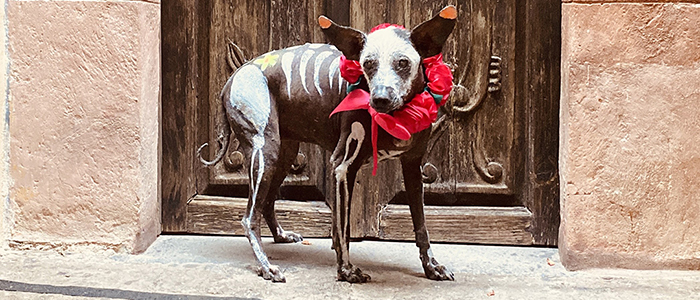At Maison Mexique, we celebrate not only the art and design of Mexico, but also its rich cultural roots—stories passed down through centuries, whispered into architecture, cuisine, textiles… and yes, even dogs. One of the most fascinating and iconic figures in Mexican heritage is the Xoloitzcuintle, Mexico’s ancient and spiritual canine companion. Pronounced show-low-eats-QUEENT-leh (we promise it gets easier), the Xolo is more than a dog. It’s a living connection to Mexico’s pre-Hispanic civilizations and one of the oldest dog breeds in the world.
Luna, our beloved Xoloitzcuintle, took center stage here at Maison Mexique during Día de los Muertos 2024, adorned in skeletal (water based, of course!) body paint and vibrant marigold garlands in homage to La Catrina.
Her presence is more than festive—it’s symbolic. As a Xolo, Luna embodies the ancient Aztec tradition of guiding souls through the underworld, and her transformation into a Catrina connects Mexico’s deep-rooted indigenous beliefs with the modern celebration of life and memory. Set against the backdrop Maison Mexique ‘s entrance and courtyard, Luna reminds us that the past is never far—it walks beside us, with heart and grace.
In many ways, Luna’s striking Día de los Muertos appearance captures everything the Xoloitzcuintle represents—mysticism, memory, and enduring cultural identity. But her story is part of a much larger one, rooted deep in the heart of Mexico. To truly appreciate this remarkable breed’s role across centuries, we invite you to journey through the history, legend, and artistry of the Xoloitzcuintle below.
A Companion from the Underworld
According to Aztec mythology, the Xoloitzcuintle was created by the god Xólotl to guide souls safely through the underworld, Mictlán. Loyal and gentle, Xolos were often buried alongside their human companions to light the way into the next life.
Their spiritual role was matched by a reputation for healing. The ancient peoples of Mexico believed Xolos had curative powers—especially for arthritis and insomnia—thanks to their naturally warm skin. Even today, their comforting warmth and calm presence make them beloved companions.
A Muse to the Modern Age
The Xolo isn’t just part of Mexico’s past—it has shaped our modern identity too. In the 20th century, Mexican artists Frida Kahlo and Diego Rivera brought new attention to the breed, often featuring their Xolos in paintings and at their famed Casa Azul. These dogs became emblems of Mexican heritage, beauty, and resilience.
Their distinctive look—sleek, statuesque, almost mythical—gives the Xolo a timeless elegance that resonates in art, design, and fashion. They’ve walked runways, graced murals, and even appeared on the big screen (Pixar’s Coco, anyone?).
A National Treasure
Declared a national cultural symbol of Mexico in 1956, the Xoloitzcuintle is a reminder of how history and mythology still walk beside us. Today, the breed thrives across Mexico and the world, recognized for its intelligence, loyalty, and quiet dignity.
You’ll often see Xolos featured in Día de los Muertos celebrations, their role as spiritual guides still honored with color and reverence. Here at Maison Mexique, we admire the Xolo for its deep cultural significance and quiet grace—a creature as soulful as the country that gave it life.
Why We Love the Xolo at Maison Mexique
Much like the spaces we create and curate at the hotel, the Xolo represents a dialogue between past and present, between the ancestral and the contemporary. Its presence—whether in sculpture, artwork, or spirit—reminds us that heritage isn’t something preserved in museums alone, but lived and loved, every day.
So the next time you spot a Xolo in a painting, parade, or plaza, take a moment to appreciate its story. After all, in a place like San Miguel de Allende, where the old and new coexist so beautifully, what better symbol than the Xolo—our quiet, ancient guardian?
Follow more cultural stories and design inspirations from Mexico right here on the Maison Mexique blog.



